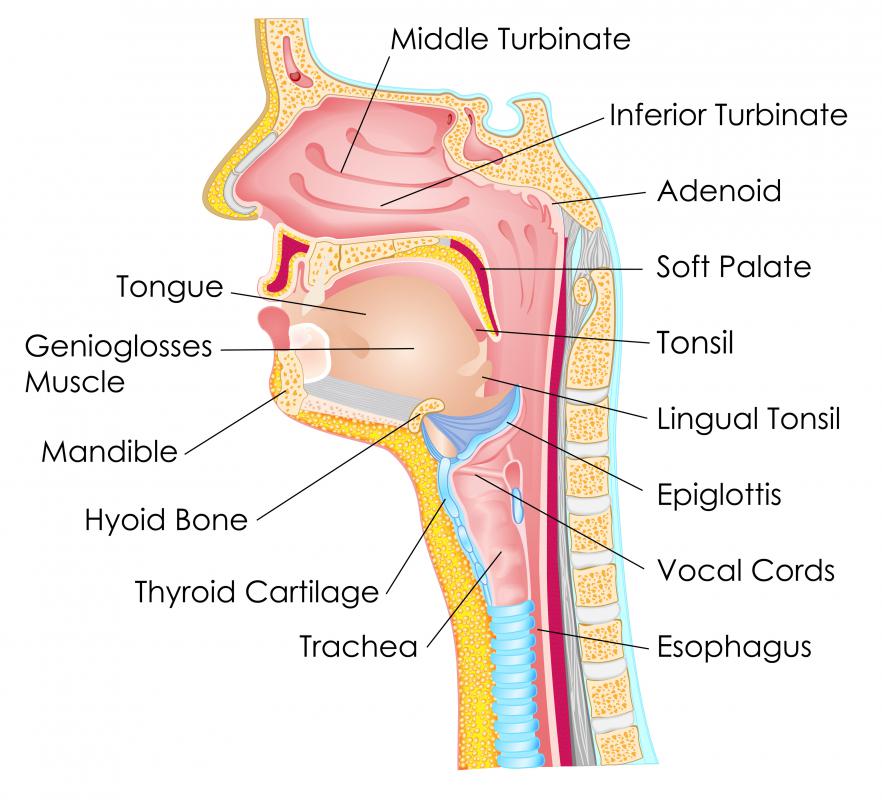At WiseGEEK, we're committed to delivering accurate, trustworthy information. Our expert-authored content is rigorously fact-checked and sourced from credible authorities. Discover how we uphold the highest standards in providing you with reliable knowledge.
What is the Ethmoid Bone?
In human anatomy, the ethmoid bone is one of the bones that make up the skull. It is situated between the nasal cavity and the brain cavity, and makes up the nasal cavity roof, part of the nasal cavity walls, part of the bony orbits around the eyes, and part of the floor of the cranium. Sometimes called the ethmoidal bone, this important structure is pneumatized, which is to say it is a spongy type of bone with light bony plates.
The ethmoid bone consists of four main parts. The structure that forms the septum of the nose is called the perpendicular plate. The two masses of bone that form portions of the orbital structure and the nasal cavity structures are called labyrinths, or lateral masses. The horizontal plate of this bone that makes up part of the bottom of the cranial space is called the cribriform plate.

There are additional structures and projections extending from the ethmoid bone. The cribriform plate gives rise to a structure called the crista galli, or "cock’s comb," to which are anchored some of the connective tissues that anchor the brain inside the skull. Delicate bony structures called turbinate bones extend from the ethmoid into the nasal cavity, where they support important mucous membranes that contribute to the sense of smell.

Due to their spongy, lightweight structure, ethmoid bones are particularly delicate and prone to injury. In situations where an upward blow to the nose is sustained, as in some automobile accidents, the plates of the ethmoid may shatter. This may result in bony fragments penetrating the brain, which can have serious side effects, and in extreme cases can even be fatal. Injuries to the ethmoidal bone may also result in damage to, or loss of, the sense of smell. This is due to the fact that the olfactory nerves, which transmit messages from the nose to the brain, pass through the ethmoid bone and if it is broken these nerves may be irreversibly damaged.

In the human ethmoid bone, there are small deposits of a magnetic iron oxide mineral called magnetite. This feature is believed to be a vestigial remnant left over from very early evolutionary times. A similar deposit is found in the ethmoid bones of some birds and fish, where it is believed to be important in biomagnetic navigation, allowing these animals to sense the direction of the Earth’s magnetic field in the same was as a compass.
AS FEATURED ON:
AS FEATURED ON:














Discussion Comments
the answer to your question copperpipe, is they are the cranial bones.
CopperPipe - you'd probably answer skull or cranium.
Is the coronal suture in any way related to the ethmoid bone, or is it just for the frontal bone and parietal bone? I have heard conflicting things, and wanted to clear it up.
Thanks.
I was wondering about the ethmoid bone in relation to the nasal bones. I had heard that the irregularities in the ethmoid could affec sinus function, and wanted to know if that was true, and if so, what the treatment would be for such a condition.
I have had some problems with my nose bones in the past, and would like to get any information that I can.
Thank you.
I need some help for my homework -- the question is: "The occipital bone, sphenoid bone, frontal bone, temporal bone and ethmoid bone are bones of the..."
The obvious answer would be the head, right? Or am I just missing something?
Any help is appreciated.
Post your comments